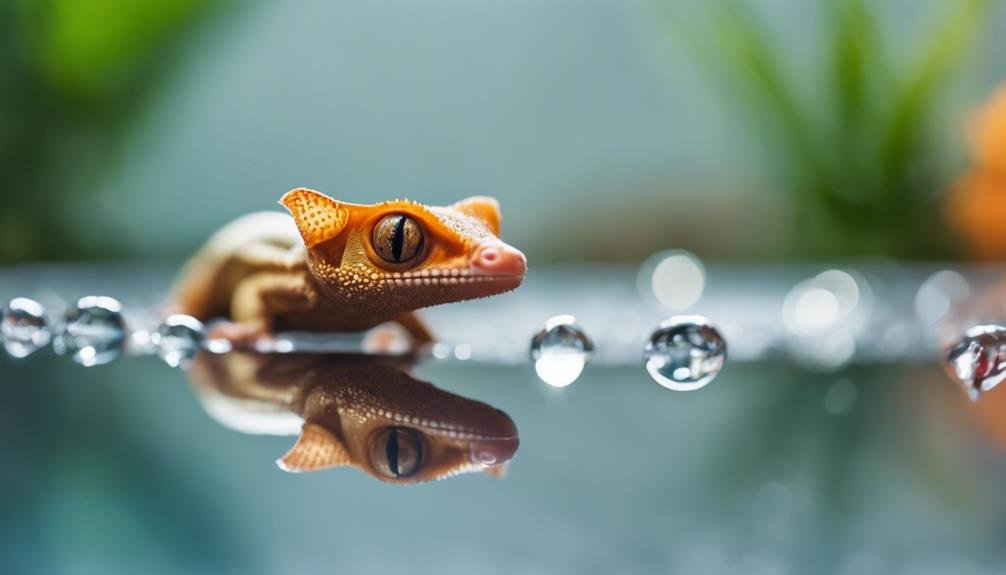If you’ve noticed your crested gecko showing signs of dehydration, such as sunken eyes or wrinkled skin, it’s essential to act swiftly. Proper hydration isn’t just about leaving a water dish in the enclosure; it involves understanding and implementing a variety of strategies tailored to your gecko’s needs. From setting up a dripping system to adjusting humidity levels, each method plays an important role in preventing dehydration. But what happens if your gecko is already dehydrated? There are immediate steps you can take to address this, but knowing the right approach is key to your pet’s recovery and long-term health. Let’s explore how you can ensure your crested gecko stays hydrated, highlighting some preventive measures and effective treatments that might surprise you.
Key Takeaways
- Monitor and adjust enclosure humidity levels to 60-80% at night and 45-50% during the day using a digital hygrometer.
- Mist the enclosure at least twice daily to maintain humidity and provide water droplets for the gecko to drink.
- Recognize signs of dehydration, such as sunken eyes and wrinkled skin, and address promptly to prevent health complications.
- Offer moisture-rich foods like cucumbers and prepared diets designed for hydration, supplementing with occasional water-rich treats.
- For quick rehydration, add electrolyte powder to water and administer with a syringe if necessary, as a short-term solution.
Understanding Crested Gecko Hydration
Understanding the hydration needs of your crested gecko is critical, as they primarily quench their thirst by lapping up water droplets from leaves and other surfaces in their enclosure. Dehydration can lead to serious health issues, including lethargy, decreased appetite, and sunken eyes. To prevent these symptoms, it’s crucial to provide proper water sources that mimic their natural environment. Shallow dishes, bottle caps, or dripping systems can offer easy access to water, encouraging your crestie to stay hydrated.
Monitoring your crested gecko’s hydration is key to maintaining their overall health. Regular checks for signs of dehydration, such as sunken eyes or a lack of energy, can help you take action before more severe health issues arise. Adjusting your hydration methods may be necessary depending on your gecko’s behavior and the conditions within their enclosure.
Ideal Humidity Levels
Maintaining the right humidity levels, ranging from 60-80% overnight and 45-50% during the day, is essential for your crested gecko’s health and hydration. These vital humidity levels play a critical role in preventing dehydration and ensuring healthy shedding. Without the right environment, your gecko might face health issues directly linked to improper humidity.
To keep on top of these levels, using a digital hygrometer is indispensable. This device helps you monitor the enclosure’s humidity accurately, allowing you to make adjustments as needed. If the humidity drops too low, your crested gecko risks dehydration, while too high can lead to mold growth, which poses its own set of health risks.
To manage ideal humidity levels effectively, consider incorporating misting systems or live plants in the enclosure. These not only help in maintaining the right humidity but also mimic your pet’s natural habitat. Adding moist hides and sphagnum moss can also retain moisture, ensuring that the habitat stays within the recommended humidity range.
Recognizing Dehydration Signs
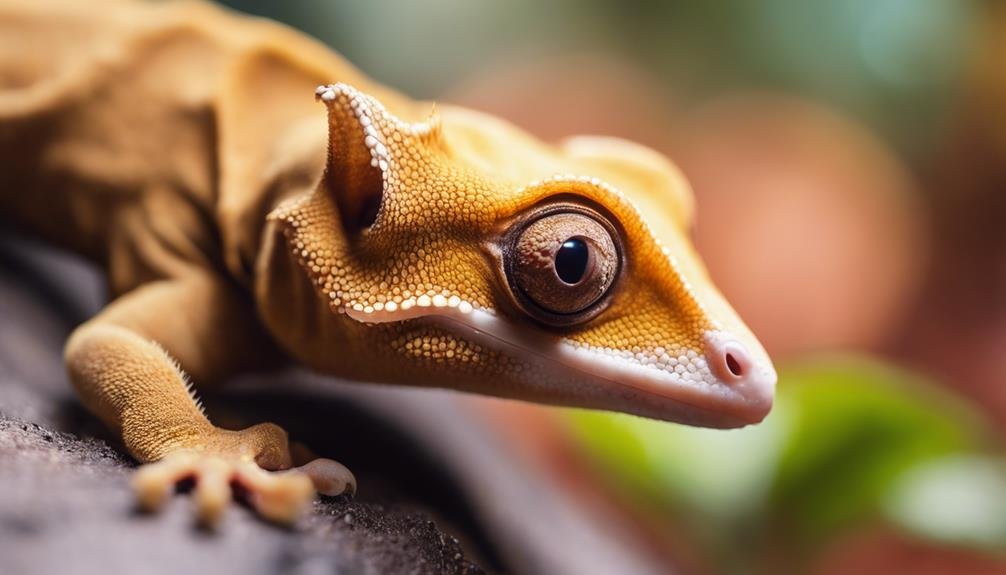

Now that you’re aware of the ideal humidity levels for your crested gecko, it’s important to recognize the signs of dehydration. If you notice sunken eyes or unnaturally wrinkled skin, your gecko could be dehydrated.
These symptoms suggest it’s time to assess and adjust your pet’s environment or hydration methods.
Identifying Dehydration Symptoms
Recognizing dehydration symptoms in crested geckos, such as sunken eyes and weight loss, is essential for their health and well-being. Monitoring for signs like protruding hips or ribs and a wavy tail is important to catch dehydration early.
Low humidity levels in their enclosure are a common cause, contributing to dehydration issues. It’s important to understand that high temperatures, infrequent misting, and offering dry food can exacerbate the problem, especially in environments with humidity levels below 60%.
Addressing dehydration promptly is crucial in preventing serious health complications. By keeping an eye out for these symptoms and understanding their causes, you can take steps towards prevention and ensure your crested gecko stays hydrated and healthy.
Sunken Eyes and Skin
Sunken eyes and dry, wrinkled skin serve as clear indicators that your crested gecko may be suffering from dehydration. When you notice these signs, it’s important to understand they’re not just cosmetic issues but symptoms of insufficient hydration that can lead to serious health issues if not addressed.
Recognizing these signs early on allows for prompt intervention, which is essential for the recovery and ongoing health of your crested gecko. Monitoring their eye and skin condition is key to evaluating their hydration status, ensuring you can take action before dehydration impacts their well-being further.
Regular Enclosure Misting Tips
To guarantee your crested gecko stays hydrated and healthy, it’s important to mist their enclosure consistently, aiming for at least twice daily. Regular misting is critical for maintaining proper humidity levels within their habitat, directly impacting your pet’s ability to stay hydrated. By creating a moist environment, you’re mimicking the natural humidity of their native habitat, which is crucial for their overall well-being.
Misting doesn’t just regulate the enclosure’s humidity; it also provides your crested gecko with water droplets to drink from, aiding in their hydration. This simple act can be a lifesaver, preventing dehydration and supporting their health. Make sure you’re misting the enclosure thoroughly, covering all areas but avoiding over-saturation, which could lead to other issues like mold or bacterial growth.
Water Source Management
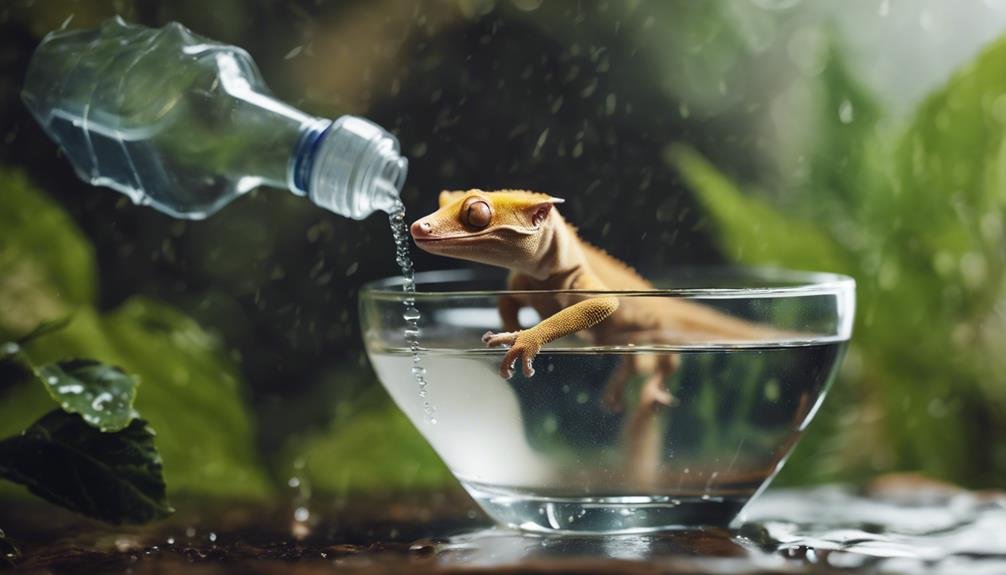

After emphasizing the importance of regular enclosure misting, it’s vital you also focus on water source management for your crested gecko. Ensuring the water bowl is correctly placed and maintaining a strict cleaning schedule can greatly impact your pet’s health.
Let’s explore how proper placement and cleanliness contribute to preventing dehydration in your beloved crestie.
Proper Water Bowl Placement
Ensuring your crestie stays hydrated starts with properly placing water bowls within their enclosure. Correct placement is vital for easy accessibility, preventing dehydration, and promoting cleanliness.
Here’s how to optimize water bowl placement for your Crested Gecko:
- Accessibility: Place water bowls in locations your gecko frequents to encourage regular drinking. Avoid tucking them away in hard-to-reach corners.
- Safety: Ensure bowls are shallow enough to prevent any risk of drowning while allowing easy access for your crestie. This makes hydration safe and straightforward.
- Distribution: Utilize multiple water bowls throughout the enclosure to provide ample opportunities for hydration from different areas, minimizing the risk of dehydration.
Regular Cleaning Schedule
Maintaining a regular cleaning schedule for your crested gecko’s water dishes is as vital as their strategic placement within the enclosure. Regular cleaning prevents bacterial growth and contamination, ensuring your pet has access to fresh, clean water. Change the water daily to maintain cleanliness.
When it’s time to clean, use mild soap mixed with water. This combination effectively removes any residue that could harm your gecko. Don’t forget to scrub the dishes with a soft brush to eliminate any buildup or debris that might’ve collected.
Adjusting for High Humidity
To address high humidity that can harm your crested gecko, start by adjusting the enclosure’s ventilation and air circulation. High humidity levels are often the culprits behind mold growth and poor shedding, conditions that can greatly affect your gecko’s health and comfort. By ensuring proper air flow, you not only prevent these issues but also create a more natural and healthier environment for your pet.
Consider these steps to adjust for high humidity:
- Increase Ventilation: Improve air circulation by adjusting the enclosure’s ventilation. This could involve adding more air holes or using a fan to gently circulate air, ensuring that humidity doesn’t build up to harmful levels.
- Use Humid Hides: Incorporate humid hides with moist sphagnum moss. These provide a microclimate with fluctuating humidity levels, essential for preventing shedding problems without raising the overall humidity of the enclosure too much.
- Monitor and Adjust: Regularly monitor the humidity levels using a hygrometer. If you notice signs of mold growth or if your gecko is experiencing poor shedding, it’s time to reassess and adjust your strategies to maintain ideal conditions.
Solutions for Low Humidity
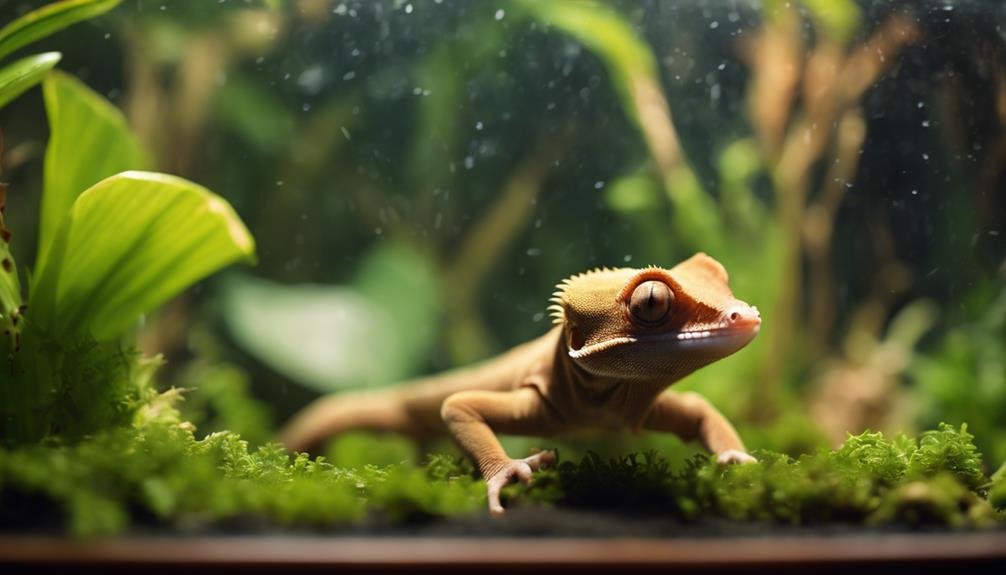

If you’ve noticed your crested gecko showing signs of dehydration, it’s time to tackle low humidity in their enclosure.
By adjusting the enclosure’s humidity levels, implementing daily misting techniques, and ensuring hydration through diet, you can create a more suitable environment for your pet.
Let’s explore how these solutions can prevent dehydration and maintain your crestie’s health.
Adjusting Enclosure Humidity Levels
Adjusting your crested gecko’s enclosure humidity levels, specifically if they drop below 60%, is essential in preventing dehydration. Low humidity is a common issue that can lead to serious health problems for your crested geckos.
To combat this:
- Monitor humidity levels diligently with a hygrometer to make sure they remain in the ideal range, preventing dehydration.
- Incorporate humid hides within the enclosure, offering your gecko a microclimate where they can regulate their moisture needs effectively.
- Utilize live plants and moist substrates to naturally boost the enclosure’s humidity, creating a more stable environment for your gecko.
Daily Misting Techniques
Implementing daily misting techniques can greatly elevate the humidity levels in your crested gecko’s enclosure, safeguarding against dehydration. By misting the enclosure in the evening, you create an ideal humid environment that mimics the crested gecko’s natural habitat.
This not only boosts the overall humidity levels but also provides essential hydration opportunities for your pet. Using a fine mist spray bottle is key, as it guarantees the water droplets are small enough for your gecko to easily access and drink from surfaces within their habitat.
Regular, daily misting is a critical component of dehydration prevention, ensuring that your crested gecko stays hydrated and healthy. Remember, consistent evening misting is your best strategy for maintaining the ideal humidity levels and offering direct hydration to your crested gecko.
Hydration Through Diet
Boost your crested gecko’s hydration by incorporating high water content diets, such as prepared foods and moisture-rich fruits and vegetables. Offering a variety of foods not only meets their nutritional needs but also helps prevent dehydration, especially in environments with low humidity.
Consider these hydration-boosting options:
- Prepared Foods: Brands like Repashy, Pangea, or Clarks are specifically designed to support your crested gecko’s hydration and nutritional needs.
- Fruits and Vegetables: Introduce cucumbers, strawberries, and carrots into their diet for an extra hydration boost.
- Live Insects: Feed them crickets, roaches, and silkworms, known for their high water content.
Including occasional treats like melons, oranges, and apples can provide additional hydration, ensuring your crested gecko remains healthy and hydrated through their diet.
Electrolyte Rehydration Methods
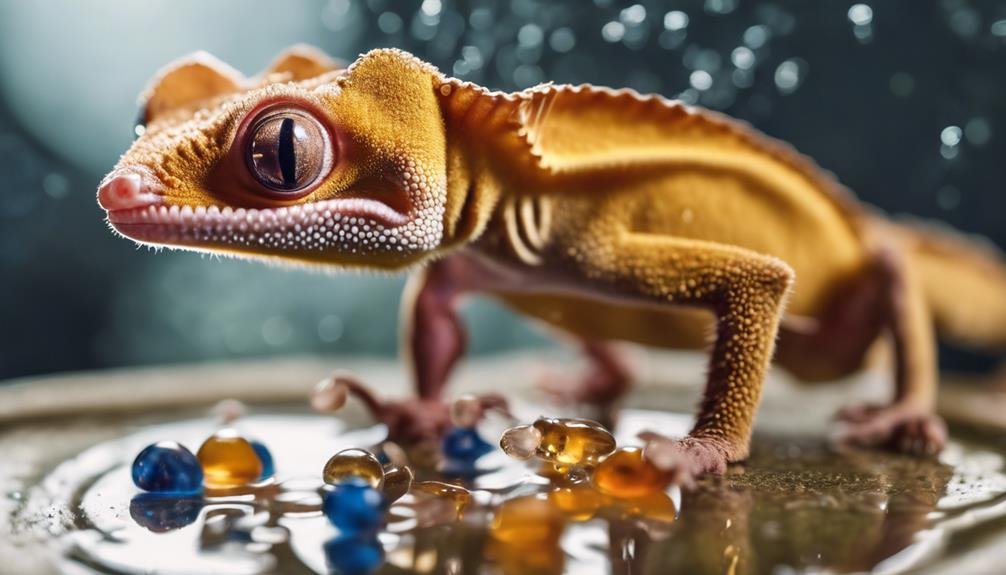

When your crested gecko shows signs of dehydration, adding electrolyte powder to its water can promptly aid in recovery. This specialized powder provides essential hydration and nutrients, important for your pet’s health. For quick rehydration, you should dissolve 1/4 teaspoon of electrolyte powder per 4 ounces of water. If your gecko is particularly lethargic or unwilling to drink on its own, using a syringe to gently administer the solution directly into its mouth is an effective method.
It’s important to remember that while electrolyte powder is a great first-aid tool for dehydration, it should only be a short-term solution. Seeking veterinary care to address the underlying cause of your gecko’s dehydration is necessary for its long-term health. Keeping electrolyte powder in your reptile first-aid kit ensures you’re always prepared for emergency rehydration needs.
Here is a quick guide to using electrolyte powder for crested geckos:
| Method | Measurement | Note |
|---|---|---|
| Electrolyte Powder | 1/4 teaspoon per 4 ounces | Important for quick rehydration |
| Administration | Syringe | Directly to mouth if necessary |
| Duration | Short-term solution | Seek veterinary care |
Preventative Care Practices
To prevent dehydration in your crested gecko, it’s vital to maintain humidity levels within the 60-80% range in their habitat. Dehydration can be a silent threat to your crested geckos, but with the right preventative care, you can guarantee they stay hydrated and healthy.
Here are three key practices to keep in mind:
- Offer clean water in shallow dishes: These allow your gecko easy access to water at all times, ensuring they can hydrate whenever they need to. It’s a simple yet effective way to combat dehydration.
- Implement frequent misting: Misting the enclosure daily helps maintain ideal humidity levels. This not only mimics their natural environment but also encourages them to lick water droplets off surfaces, aiding in their hydration.
- Monitor for signs of dehydration: Keeping an eye out for dehydration signs like sunken eyes and increased urate output is important. Recognizing these early signs can help you take immediate action to adjust their environment or hydration methods.
Seeking Veterinary Assistance
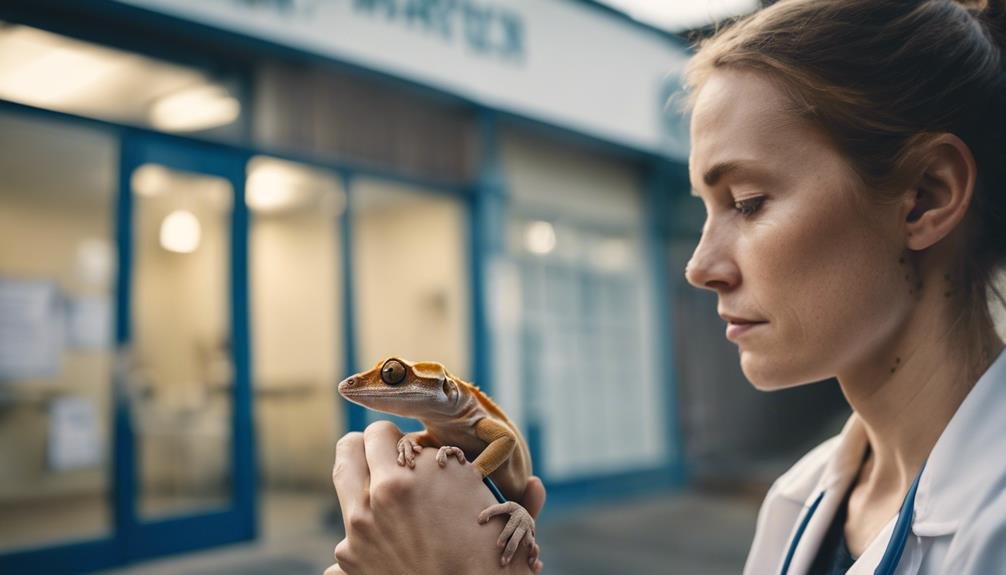

Despite your best efforts to prevent dehydration in your crested gecko, there may come a time when you’ll need to seek professional help from a reptile-experienced veterinarian. When you notice signs of dehydration, it’s important not to delay in getting veterinarian assistance. A qualified vet can evaluate your dehydrated crested gecko, examining its condition to provide the right treatment and adjust its hydration needs accordingly.
Prompt action is key to preventing more serious health complications. By consulting with a veterinarian, you guarantee your crested gecko receives tailored treatment plans designed for its specific situation. Additionally, establishing regular check-ups with a reptile vet is important for keeping an eye on your pet’s overall health and hydration status.
Here’s a brief overview to guide you in seeking the right veterinary care:
| Need | Why It’s Important | How to Proceed |
|---|---|---|
| Evaluation | Assess the severity of dehydration | Find a reptile-experienced vet |
| Treatment | Address immediate hydration needs | Follow vet’s tailored treatment plans |
| Regular Check-Ups | Monitor health and hydration status | Schedule visits as recommended by vet |
What Foods to Avoid for Dehydrated Crested Geckos and How to Prevent Dehydration?
When it comes to crested geckos and food options, it’s important to avoid feeding them dry, hard-to-digest insects like mealworms and crickets. Instead, opt for moisture-rich foods like ripe fruits and gut-loaded insects to prevent dehydration. Also, ensure they have access to a shallow water dish at all times.
Frequently Asked Questions
How Do You Help a Dehydrated Gecko?
To help a dehydrated gecko, you’ll want to start with water offerings on leaves or in shallow dishes. Check the humidity levels in their enclosure and adjust your misting frequency to keep it at the best level. Avoid soaking sessions as they prefer to drink orally.
Look out for signs of good hydration, like skin elasticity. If their condition doesn’t improve, it’s essential to consult a vet for professional advice and treatment options.
How Do You Rehydrate a Lizard?
To rehydrate your lizard, start by misting their enclosure with water or setting up a drip system for them to drink from. Offer shallow dishes of water and consider lukewarm soaks for skin absorption. Watch for hydration signs like active behavior and regular urate output. Using electrolyte solutions can also help.
Make sure the environmental humidity is right, and if you’re worried, don’t hesitate to consult a vet for advice.
Why Is My Gecko Dehydrated?
Your gecko might be dehydrated due to improper humidity, inadequate water, or health issues. Environmental stress, nutritional deficiencies, heat stress, and a poor diet can also contribute.
If the enclosure’s too dry or hot, it’ll affect their hydration. Not getting enough water or the right nutrients compounds the problem.
To tackle dehydration, you’ll need to check these factors closely and make necessary adjustments to their habitat and diet.
How Do I Get My Crested Gecko to Drink?
To get your crested gecko to drink, focus on water placement in shallow dishes and consider a drip system to mimic natural conditions. Guarantee the water quality is high—avoid distilled or softened water.
Increase misting frequency to boost humidity levels, which supports their drinking habits. Nighttime hydration is key, as they’re more active then.
Monitoring and adjusting these factors can greatly improve their hydration and overall well-being.
Conclusion
Keeping your Crested Gecko well-hydrated is essential for their health. Make sure their habitat maintains ideal humidity levels and watch for signs of dehydration like sunken eyes or wrinkled skin.
Regular misting and providing various water sources can help prevent dehydration. If they do become dehydrated, offering electrolyte solutions can aid in rehydrating them quickly.
Remember, prevention is vital, so follow these care practices diligently. If you’re ever in doubt, don’t hesitate to seek veterinary assistance to keep your gecko healthy and happy.

